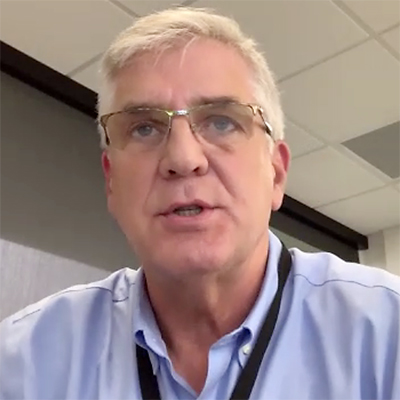Task Force Suggests Framework for DC Ties’ Use
SPP’s Strategic Planning Committee last week approved a task force’s recommended framework to manage DC tie revenue-requirement recovery as part of the grid operator’s proposed RTO West.
The DC Tie Task Force’s proposed market efficiency use (MEU) mechanism would compensate DC ties for their market use and be applied to DC-tie market dispatch beyond network and point-to-point use. The group said that would ensure their market use is properly compensated for and does not adversely affect the DC tie’s host zone.
The task force also said SPP staff should continue to engage with Western parties and its membership to fully develop an MEU rate and applicability details before April 15 and suggested a DC tie congestion-hedging task force develop a final proposal for a congestion-hedging methodology.
 Tom Christensen, Basin Electric | SPP
Tom Christensen, Basin Electric | SPPBasin Electric Power Cooperative’s Tom Christensen was the lone SPC member to vote against the task force’s motion, citing concerns with continued congestion and increased maintenance costs for the 200-MW DC tie in Rapid City, S.D., that Basin co-owns with Black Hills Power and Light.
“With significant use, we expect maintenance costs to increase,” he said. “Our most significant concern … is that whatever approach is selected needs to provide an incentive for other entities to join the SPP West effort and for other DC ties to be constructed. Without that, the benefits to both East and West will be unnecessarily constrained. We encourage a more holistic, broader view of what we consider a very substantial opportunity.”
SPP would be the first RTO to consolidate two balancing authorities DC ties with its Western membership. A Brattle Group study found that RTO West would produce $49 million in annual savings for current and new members. Western utilities would receive $25 million a year in adjusted production cost savings and revenue from off-system sales. Members in the Eastern Interconnection would benefit from $24 million in savings because of the market’s expansion, transmission network and generation fleet.
Assuming FERC approval of Tariff changes, SPP expects RTO West to become a reality in 2024. The gird operator already manages the Western Energy Imbalance Service market, which launched in February, for eight participants.
‘Custom’ Cost Allocation Coming?
SPP Engineering Vice President Antoine Lucas told the committee that the grid operator’s joint targeted interconnection queue (JTIQ) project with MISO will involve a custom cost-allocation approach “designed to fit this study and process.” The mechanism will also help the staffs overcome some of the hurdles they have faced in trying to work together on interregional projects.
Lucas said one rubric being discussed is how to allocate portions of different loads and how to allocate generation to the various generators involved in the process. (See MISO, SPP: Economics Secondary in Joint IC Planning.)
Separating cost allocation from the rest of the JTIQ work will help the project remain on track, Lucas said. A draft report will be drafted later this month.
Renewable developers are commending the JTIQ project, NextEra Energy Resources’ Matt Pawlowski said in speaking for the community.
“It’s evident from the last meeting that you’re working hard together to come up with solutions,” he said. “There’s potential to get a lot of these projects built and it will unlock a lot of value for folks. We continue to strive for more certainty on the cost and the schedule, as we do for all interconnection schedule, so we know what we’re signing up for. The closer we get to that, the more projects we’ll build.”
Competitive Upgrade Changes
The committee approved a task force’s recommendation to amend a business practice that the group said will improve the volume and quality of submissions in SPP’s competitive transmission-upgrade process.
The Transmission Owner Selection Process Task Force modified Business Practice 7650’s language so that its criteria for detailed project proposals clarify that they are equivalent to a transmission project in the recommended portfolio. The submitted projects will need to reduce thermal loading below 100% or improve the per-unit voltage values between 0.9/unit and 1.05/unit and also be within 50% of congestion mitigation for each economic need solved.
SPC also agreed with the task force’s proposal to require incentive points be considered by the industry expert panel (IEP) responsible for grading and selecting the transmission owner to build a competitive project. That is a policy change from the current practice of not placing any parameters on the IEP. The task force did retain tariff language allowing the panel to recommend a project besides the one with the highest score.
“We feel the incentive points are an integral part of the process,” said American Electric Power’s Brian Johnson, the task force’s chair.
Altenbaumer Ends Chairmanship
Board of Directors Chair Larry Altenbaumer ended his two-year term as the SPC’s chair on a high note, ending the meeting just three minutes short of its scheduled end time.
“I couldn’t be more excited about SPP’s future, and I look forward to working with all of you in other formats in the future,” he said before the meeting adjourned.
Altenbaumer will be replaced by Director Mark Crisson.
The SPC will also need to replace Evergy’s Kevin Noblet and Nebraska Public Power District’s Traci Bender next year. Noblet is leaving Evergy, and Bender’s term has ended.


